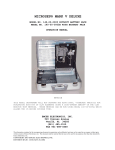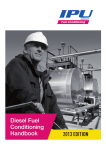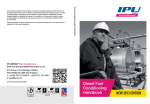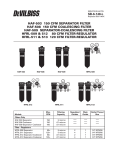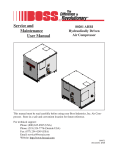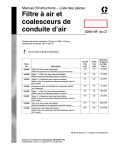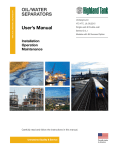Download Troubleshooting your Compressor
Transcript
Troubleshooting your Compressor Compressor won’t start when on/off switch is turned on? 1 3 1. Check battery power to unit and all wire connections to ensure they are tight and no loose connections are present. 2 2. Check blowdown pressure switch located behind inlet valve. This normally closed pressure switch is used to prevent the compressor from re-engaging under full pressure. The pressure switch will remain open and prevent engagement of the compressor until the system “blows down” or relieves itself of internal pressure. If the system is void of power, current will flow through this pressure switch and permit the compressor start up. No current at this point indicates that you have a faulty switch. Blowdown Pressure Switch 1 3. Check reset button on the front of the compressor to see if the safety breaker relay (on switch) has been tripped. You can reset the breaker and the compressor unit should start; but prior to using the compressor a determination should be made as to what caused the breaker to trip. The problem must be resolved before continuing operation of the compressor (See Unexpected System Shutdowns in this guide.) 117 Safety Reset Breaker 4. Check front panel of compressor and see if oil level light system is indicating low oil level. The compressor safety system will not engage if the oil level is too low. 1 5. Check to see that the belt is in place and in good working condition. If not it should be replaced. It is a good idea to always keep a new belt on hand. When replacing the belt, check clearances to guards and pulleys for any rough spots. Make certain that the belt is running true, as a miss aligned belt will greatly reduce belt life. 2 6. Check the fuse on the Murphy switch. If it does not have continuity, it should be replaced. 3 The compressor unexpectedly shuts down. Automatic safety shutdowns have been integrated into the compressor to prevent excessive pressures and temperatures. This is accomplished by the use of temperature and pressure gauges that include safety shutdown contacts in them. The indicator needle on the gauge acts as the switch pole that completes the circuit when it touches the limit contact. This trips the reset button (117 switch). Both the pressure and temperature safety systems utilize these switch gauges. If the 117 switch has tripped it may be necessary to watch the gauges during operation to determine which is causing the shutdown. Normal operating temperatures are between 160 and 190 degrees and the furnas switch is factory set at 150 on the high side. Therefore, the limit switches are factory pre-set at 175 psi maximum pressure and 240 degrees maximum temperature gauge. It is possible to manually adjust these settings so your first check it to insure they are set to the proper positions. 117 Reset Breaker & Pressure Gauge High temperature shut downs must be corrected prior to continued use of the compressor system. Areas to check are: 1 1. With compressor off check oil level in compressor both visually and by indicator switch to verify proper level, make sure compressor fluid is clean. 2 2. Check cooler for dirt and contamination in cooling fins 1 a. If plugged, steam wash cooler core and blow debris from cooler with shop air 2 3 3. Check to insure ambient air is permitted to enter the compressor unit. Make sure there is no obstruction of vents or coolers. 4. Check thermal valve next to oil filter to insure it is passing oil properly to the cooler this can be checked by feeling the hoses for heat. Flows to the cooler should start at approximately 180 degrees. 4 5 7 5. Check intake filter condition by removing filter located on top of compressor, remove filter clean or replace. 6. Insure that the air inlet on the compressor is positioned to intake ambient air and is not positioned where it would intake exhaust or engine heat. 6 7. Check temperature gauge is working. If need be check for accuracy via infra red heat gun device at oil discharge port of compressor or cooler. High pressure shut downs must be corrected prior to continued use of the compressor system. Areas to check are: 1. Check furnas switch for proper operation; it should be sending signals to stop at 150 lbs. 1 2. Check pressure gauge on instrument panel for accuracy with discharge pressure by installing a secondary pressure gauge in the discharge line, replace if needed. 3. Check the pressure gauge on the compressor versus the gauge on the FLR, if differential is greater than 20 check for air line restrictions and condition of coalescing element 0 a. If coalescing element is plugged or restricted remove and replace 4. Check if regulator solenoid is functioning properly, this is achieved by checking the ¼ inch elbow tube fitting at the solenoid which has a 3/64 inch hole and should be blowing air when the regulator sends a signal to close the inlet valve 1 5. Check to confirm furnas switch is operating properly by watching contacts or checking contacts with digital multi-meter 6. With machine off check inlet valve for functionality 1 7. With machine off check teflon o-ring in inlet valve by simply pushing the piston open and running index finger around backside of o-ring for nicks, cuts or damage, o-ring should be smooth 0 a. If there is no damage to o-ring make sure 117 safety relay switch has not popped out, make necessary repairs rerun and retest Inlet Valve 1 2 5. Check coalescer scavenger line sight glass which is located on top of compressor next to coalescer element, when working properly one should see slugs of oil in sight glass, if no oil is visible scavenge line is not working 6. With compressor off check discharge valve 1 7. Check minimum pressure valve 1 a. Remove minimum pressure valve located on side of compressor closest to coalescer element 2 b. Remove, inspect visually 3 c. Lubricate and reinstall Minimum Pressure Valve 1 9. Check relief valve, could be defective or weakened from repeated pop offs. Recovery time is slow on systems with storage tanks. 1 2 1. Check to insure all moisture is bled out of air storage tank (if equipped with) 3 4 2. Check for hose restrictions from compressor to air storage tank (if equipped with) 5 6 3. Check for restrictions from air tank to FLR or hose reel (if equipped with) 7 8 4. Check FLR and entire hose reel for restrictions 9 10 5. Check compressor speed by using a hand held photo tachometer. If compressor speed is incorrect correct compressor speed before further testing 11 12 6. Check if regulator solenoid is functioning properly, this is achieved by checking the ¼ inch elbow tube fitting which has a 3/64 inch hole you should not feel air blowing below 110 lbs pressure 13 14 7. Check for open service valve or other air leaks in system Low discharge pressure. If discharge pressure is too low, check the following: 1 2 1. Too much air demand. (Air tools require more air than what the compressor can produce, air tools are free wheeling without resistance.) 3 4 2. Service valve wide open to atmosphere 5 6 3. Leaks in air lines 7 8 4. Restricted compressor inlet air filter 9 10 5. Check if regulator solenoid is functioning properly, this is achieved by checking the ¼ inch elbow tube fitting which has a 3/64 inch hole you should not feel air blowing below 110 lbs pressure 11 12 6. Check compressor coupling speed by using a hand held photo tachometer 13 14 7. Check regulator solenoid for debris 15 16 8. Remove, inspect and clean solenoid and hose going to inlet valve elbow 17 18 9. With compressor off, check inlet valve operation manually 19 20 10. Check to confirm furnas switch is operating properly by watching contacts or checking contacts with digital multi-meter Pressure on the FLR is lower than pressure on the compressor. 2 4 1 1. Check regulator on FLR and make sure functioning 3 2. Test gauge on FLR for accuracy 5 6 3. Check to see if air storage tank has been installed on truck a. If so make sure all moisture is bled out of tank to insure proper operation of tank 0 1 2 3 4 5 6 4. Check for hose restrictions from compressor to air storage tank 5. Check for restrictions from air tank to FLR or hose reel 6. Check FLR and entire hose reel for restrictions 7. Check compressor speed by using a hand held photo tachometer. If compressor speed is incorrect correct compressor speed before further testing 1 2 8. Check if regulator solenoid is functioning properly, this is achieved by checking the ¼ inch elbow tube fitting which has a 3/64 inch hole you should not feel air blowing below 110 lbs pressure 3 4 9. Check for air leaks in system Compressor slowly builds up pressure when service valve is closed or no air demand is present. Eventually the unit will shut down due to high pressure. If this occurs check the following: 1 2 1. Check teflon o-ring in inlet valve for damage 3 4 2. Check shaft seal leakage for oil coming out during shut down only 5 6 3. Check if regulator solenoid is functioning properly, this is achieved by checking the ¼ inch elbow tube fitting which has a 3/64 inch hole and should be blowing air when the regulator sends a signal to close the inlet valve Compressor oil comes out of air cleaner. 2 3 4 0 1 1. With machine off check inlet valve for functionality, the piston should close at shut down and act as a check valve for oil in the air filter 2. With machine off check teflon o-ring in inlet valve by simply pushing the piston open and running index finger around backside of o ring for nicks, cuts or damage, o-ring should be smooth a. If there is no damage to o-ring make sure 117 safety relay switch has not popped out, make necessary repairs rerun and retest. Emergency shut down may cause some oil to vent into the air cleaner. Compressor oil comes out of blowdown valve. 2 1 1. With compressor off, check oil level in compressor both visually and by indicator switch to verify oil level, excessive oil level may cause this. 1 2 3 4 2. Check plumbing of blow down valve the “P” marking on valve should be connected to inlet valve plate and “I” marking should go to ¼ inch tube going to fresh air port of compressor 3. Check blowdown valve for functionality and shifting to insure not stuck or sticking 4. Check coalescer scavenge line sight glass which is located on top of compressor next to coalescer element, when working properly one should see slugs of oil in sight glass, if no oil is visible scavenge line circuit is not working Oil is coming from air service valve. 1 21. With compressor off check oil level in compressor both visually and by indicator switch to verify oil level, excessive oil levels will cause “oil carry over” into the air lines. 3 42. Check coalescer scavenge line sight glass which is located on top of compressor next to coalescer element, when working properly one should see slugs of oil in sight glass, if no oil is visible scavenge line circuit is not working Why do I go through coalescers frequently? If the coalescer element has to be replaced frequently because it is plugging up, it is an indication that foreign material may be entering the compressor inlet or the compressor oil is breaking down. Compressor oil can break down prematurely for a number of reasons: 1 2 1. Extreme operating temperature 3 4 2. Negligence in draining condensate from oil sump 5 6 3. Using the improper type of oil 7 8 4. Dirty oil 9 10 5. Oil return nozzle plugged Preventing excessive moisture in air systems A natural by product of compressed air is moisture. The amount of water created by compressing air varies directly with ambient temperature and humidity. Higher temperature and higher humidity levels create more moisture. This moisture causes several problems in various areas of compressed air systems. To minimize or eliminate the problems associated with moisture we recommend the following: 11. Relieve compressor of all air pressure and drain moisture from bottom of oil reservoir. Perform the procedure more frequently during hot humid periods. 2 32. Whenever possible run the compressor for longer periods to get system temperatures above 180 degrees, this will remove some of the moisture in the system and push it down line toward the service valve. 4 53. If using an air storage tank, remove all air pressure and drain. This should be done daily. 6 74. The use of moisture traps and filters will assist in the removal of moisture from the system.









